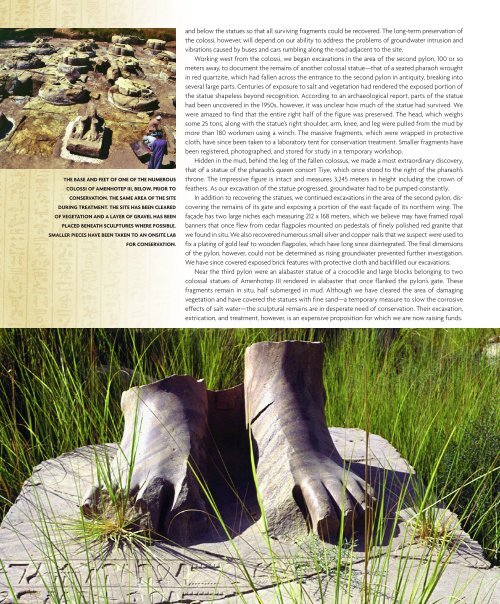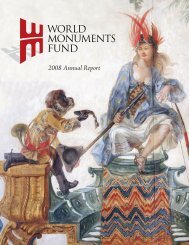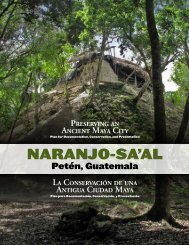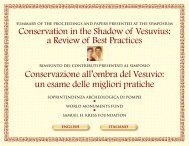BURIED FOR MORE THAN 3,300 YEARS, REMNANTS OF ...
BURIED FOR MORE THAN 3,300 YEARS, REMNANTS OF ...
BURIED FOR MORE THAN 3,300 YEARS, REMNANTS OF ...
Create successful ePaper yourself
Turn your PDF publications into a flip-book with our unique Google optimized e-Paper software.
The base and feeT of one of The numerous<br />
colossi of amenhoTep iii, below, prior To<br />
conservaTion. The same area of The siTe<br />
during TreaTmenT. The siTe has been cleared<br />
of vegeTaTion and a layer of gravel has been<br />
placed beneaTh sculpTures where possible.<br />
smaller pieces have been Taken To an onsiTe lab<br />
for conservaTion.<br />
and below the statues so that all surviving fragments could be recovered. The long-term preservation of<br />
the colossi, however, will depend on our ability to address the problems of groundwater intrusion and<br />
vibrations caused by buses and cars rumbling along the road adjacent to the site.<br />
Working west from the colossi, we began excavations in the area of the second pylon, 100 or so<br />
meters away, to document the remains of another colossal statue—that of a seated pharaoh wrought<br />
in red quartzite, which had fallen across the entrance to the second pylon in antiquity, breaking into<br />
several large parts. Centuries of exposure to salt and vegetation had rendered the exposed portion of<br />
the statue shapeless beyond recognition. According to an archaeological report, parts of the statue<br />
had been uncovered in the 1950s, however, it was unclear how much of the statue had survived. We<br />
were amazed to find that the entire right half of the figure was preserved. The head, which weighs<br />
some 25 tons, along with the statue’s right shoulder, arm, knee, and leg were pulled from the mud by<br />
more than 180 workmen using a winch. The massive fragments, which were wrapped in protective<br />
cloth, have since been taken to a laboratory tent for conservation treatment. Smaller fragments have<br />
been registered, photographed, and stored for study in a temporary workshop.<br />
Hidden in the mud, behind the leg of the fallen colossus, we made a most extraordinary discovery,<br />
that of a statue of the pharaoh’s queen consort Tiye, which once stood to the right of the pharaoh’s<br />
throne. The impressive figure is intact and measures 3.245 meters in height including the crown of<br />
feathers. As our excavation of the statue progressed, groundwater had to be pumped constantly.<br />
In addition to recovering the statues, we continued excavations in the area of the second pylon, discovering<br />
the remains of its gate and exposing a portion of the east façade of its northern wing. The<br />
façade has two large niches each measuring 212 x 168 meters, which we believe may have framed royal<br />
banners that once flew from cedar flagpoles mounted on pedestals of finely polished red granite that<br />
we found in situ. We also recovered numerous small silver and copper nails that we suspect were used to<br />
fix a plating of gold leaf to wooden flagpoles, which have long since disintegrated. The final dimensions<br />
of the pylon, however, could not be determined as rising groundwater prevented further investigation.<br />
We have since covered exposed brick features with protective cloth and backfilled our excavations.<br />
near the third pylon were an alabaster statue of a crocodile and large blocks belonging to two<br />
colossal statues of Amenhotep III rendered in alabaster that once flanked the pylon’s gate. These<br />
fragments remain in situ, half submerged in mud. Although we have cleared the area of damaging<br />
vegetation and have covered the statues with fine sand—a temporary measure to slow the corrosive<br />
effects of salt water—the sculptural remains are in desperate need of conservation. Their excavation,<br />
extrication, and treatment, however, is an expensive proposition for which we are now raising funds.
















